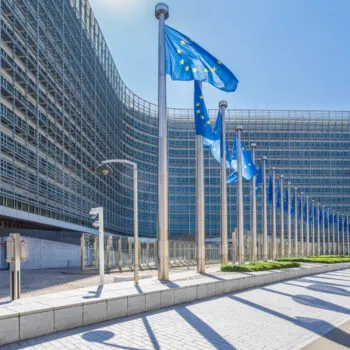Seven signatories representing a diverse range of stakeholders, including E3G, signed a joint letter calling on the European Commission to deliver an ambitious update of the EU Industrial Strategy, which supports the delivery of the European Green Deal.
Open Letter
We welcome the forthcoming update of the EU Industrial Strategy. The update provides a critical
opportunity to respond to the ongoing economic fallout of the COVID-19 crisis. It is also a chance to ensure the EU’s increased 2030 emissions reduction target of -55% speeds the transition to net-zero emissions for European industries.
In our view, the last version of the strategy failed to provide a coherent policy framework for accelerating this transition. We can’t afford to miss this chance again. As well as the climate imperative, there is a clear economic reason: US President Biden has taken office heralding a huge increase in US climate ambition with the aim to make the world’s biggest economy climate neutral by 2050. China has also adopted a carbon-neutrality goal for 2060. We now live in a world where 75% of nations are aiming for carbon neutrality, and where three of the world’s five largest steel companies (all headquartered in Asia) have adopted net-zero 2050 pledges. These shifts ramp up pressure on the EU to transition its industry as quickly as possible, or risk squandering a key strategic move to ensure competitive sustainability.
To ensure a greener EU industrial strategy, we believe the update should prioritise four areas:
- Scale up innovation funding. In the updated strategy, the Commission should highlight concrete policies and actions to scale up innovation funding for industrial transformation. The first call for the Innovation Fund launched last year was 20 times oversubscribed. This clearly shows the huge appetite for more funding in this area. The upcoming EU ETS revision presents an opportunity to ensure more funding for breakthrough decarbonisation and negative emissions technologies. The Commission should signal its intention to rapidly reduce the number of free allowances allocated, and use the resulting revenues for the Innovation Fund or to fund EU-level Carbon Contracts for Difference to support the first generation of commercial climate-neutral industrial production sites. We also recommend expanding the use of the European Alliances format to deepen the focus on industrial transformation, e.g. through the creation of a European Green Steel Alliance.
- Ensure the EU becomes a global green industrial market creator. In the last version of the Industrial Strategy there was a welcome focus on building lead markets for cleaner industrial materials but little detail on how this would be achieved. In the updated EU industrial strategy, the Commission should set out a coherent framework for pushing this forward: laying out a pathway to develop ambitious green and circular product requirements in the Sustainable Product Initiative and the revised Ecodesign Directive and linking these product requirements to public and private procurement policies. Currently, the focus in these legislative files is limited to textiles and batteries. Given the long lifetime of industrial assets, we need a clear policy signal that carbon-intensive industrial products like steel and cement will be addressed in the near-term, for example, via mandatory Environmental Product Disclosures. Establishing these at EU-level will be crucial: fragmentation in environmental standards for clean technologies prevents innovative European cleantech companies from scaling up in the way their US and Chinese competitors do in their own domestic markets. But this is also about leveraging the EU’s global standard setting power, e.g. partnering with steel producers internationally to define a green steel standard and linking that to trade measures at the border, creating a huge EU single market pull for green steel internationally.
- Strengthen the link between the green and digital transitions. The European Commission has consistently referred to the “twin green and digital transitions,” placing these two agendas side by side but not yet properly connecting them to reap the synergies and manage the risks they present to each other. The updated strategy is a chance to bring them together in one coherent framework allowing us to identify areas where both agendas can be strengthened and reinforced. As the European Investment Bank recently recalled: “Europe registered 76% more patents that combined both green and digital technologies than the United States, and four times more than China”. It is now time to turn this technological advantage into a competitive advantage for EU companies. This means putting in place dedicated initiatives to support the digital transformation in the energy system, industrial sectors, and the broader built environment where these interventions accelerate the climate-neutral transition: e.g. encouraging the use of digital design tools that consolidate data on the carbon- and material-intensity of key construction materials and allow coordination between key players to lower the embodied carbon of a construction project, smart grids which offer better demand response options for industry, the use of software at the plant level to allow for maximum energy and material-efficiency gains in the production of industrial materials, or access to data from renewable energy plants.
- Strong governance. The EU Industrial Strategy should kick off a process rather than list a set of policies. This requires a strong governance framework to monitor progress, define targets, establish systems for evaluation and reporting and support access to information and transparency for civil society and the private sector. To be effective, a competent, empowered governance body within the Commission is required. It should be sufficiently politically independent or detached from political pressures, yet accountable for its achievements, with a set of clear, realistic milestones and metrics.


